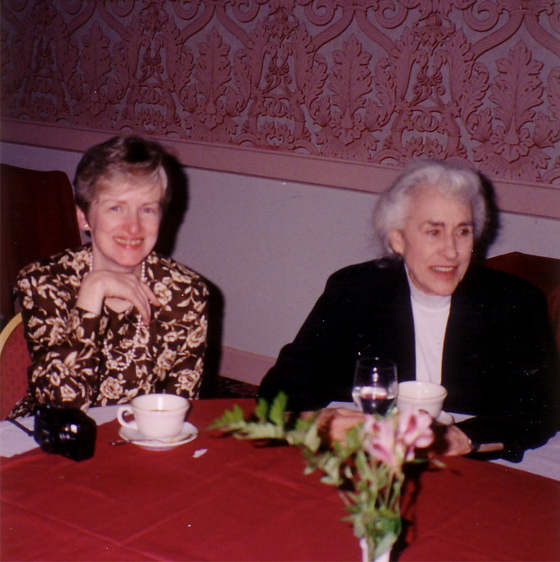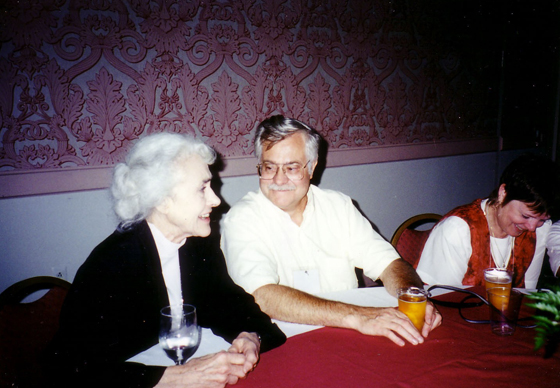Home Research Centers Marylou Ingram

Recollections of our Graduate Student Days in the lab of Dr. Marylou Ingram
by Alex Nakeff and Carl Stewart
Our mentor, Marylou Ingram, M.D., is a graduate of the University of Rochester School of Medicine and Dentistry, Rochester, NY. Her career in academic medicine, medical research and teaching has centered on experimental hematology, radiation biology, cellular biology and immunology and automated systems for cell analysis. She played a key role in the development of the first automated system for classifying white blood cells by means of image analysis. She also contributed to the development of flow cytometry during two years (1975-77) at the University of California Los Alamos Scientific Laboratory as Principal Investigator on NCI-funded contract research, “Automated Cancer Cell Analysis and Sorting,” that utilized advanced experimental flow cytometry systems.
Dr. Ingram’s project in the early 60s was to publish a bibliography called “Biological Effects of Ionizing Radiation”. This consisted of more than 12,000 annotated references with extensive cross-referencing from the time of Roentgen to about 1965 and was published by the US Gov. Printing Office in 1966 (TID-3097). All of her students worked on it and helped her collate all the papers ever written on the subject. This project consumed her for several years. This was accomplished before the time of computers and spreadsheets using the extensive Dewey Decimal style outline that she developed for cross-referencing. This outline was also published as a small companion volume to the abstracts.
When Carl and Alex were graduate students in Marylou’s lab (1964 – 1968), other students included Alan Coopersmith, Joe Traynor, and Phil Cooper. Chet Herman’s wife, Mary, (now Mary Chyun) was Marylou’s secretary. Alan and Nancy Minter were accomplished musicians and wrote songs such as “Who Put the Sugar in my Buffer Blues.” All of the students had research projects dealing with some aspect of hematology. Carl’s area of research was lymphopoiesis, Alan Coopersmith’s was erythropoiesis, Alex’s was megakaryocytopoiesis, and response to severe, acute blood loss. Joe studied megakaryocyte production and morphology during recovery from severe acute blood loss. Phil studied the release of hematopoietic progenitor cells into the circulation following high dose, whole or partial body radiation exposure. All these studies were made using early image cytometry (Rochester-style) and computer imagery to automate cell differentials, including early development of “spinner” centrifuge techniques for uniform microscopic slide preparation and staining.

Left to right, Mary Chyun and Marylou Ingram at the GLIIFCA meeting in 1994 at the St Regis in Detroit
Marylou collaborated with Ken Preston and colleagues at Perkin Elmer to develop an image-based automated cell identification system. As graduate students, all were involved in cell pattern recognition viewing microscopic slides of blood cells projected in a dark room where they identified the cells and then compared these to machine interpretations. The criteria for this identification were reduced to rules for the computer.
Early flow cytometry development included work on the Model A Coulter Counter that electronically measured the number of cells, as well as the Model B Coulter Counter that also measured the size distribution by resolving the formed elements using volume distribution e.g. electronic log normal platelet distributions (Alex/Nancy); lymphocyte blasting with mitogens and development of the first method to count lymphocytes responding to PHA using the Coulter Counter; microcyte, normocyte and macrocyte resolution by volume (Alan) and their response to acute blood loss, in addition to the description of reticulated rbc’s and platelets and the determination of hematopoietic cell cycle parameters.
At the University of Rochester, there were only one or two women in their medical school classes when Marylou attended. She had a very technical acumen. She took great pride in her students’ accomplishments and gave them credit for them. She was very approachable and favored new ideas such as when Carl added a pulse height analyzer to expand the Model B Coulter Counter’s capabilities. She loved instruments and new inventions and kept many oddities in her office and in her home. She and the students met with companies’ (especially Coulter) reps to discuss new ideas.
She was always non-political and never forgot she was a woman in (at that time) a man’s field. She had to deal with a number of arrogant male scientists many of whom did not like dealing with a woman.
She encouraged her “progeny” to publish their work in a timely manner as they finished any particular series of experiments. Then when it was time to submit our thesis it was just a matter of putting together our publications. Carl continued this same philosophy with his students with varied success. She always invited an expert to come and critique the student’s work to promote thought and new ideas e.g. Gene Cronkite, Nat Berlin, Vic Bond, Neal Wald, Fred Stohlman. She gave many dinner parties for visiting guest speakers she invited to the lab for us to interact with them.
She always supported us in front of any critics, while, on the other hand, being critical yet positive of our work face-to-face. She had an open door policy whenever we needed her advice and counsel. Her piled high desk was always and still is in evidence. She still tells of the time that Alan Coopersmith asked her to read a revision he had just make in this thesis and she told him, “Sure, just put in on my desk.” To this he replied, “Not on your life! That is like putting it on quicksand!”
Another of her memories she recounted to Carl: “The Coulter Model B counter came with its own primitive 13 channel pulse height analyzer but I clearly remember your designing and assembling, absolutely from scratch, a radioactivity counter for the experiments on the effects of iodinating cell membrane proteins and erythropoiesis studies. It was an elegant little package.”
She has a great zest for life, still wears bright scarves – a different one each day around her neck. She loves music, plants, and old movies. She now lives in a Spanish hacienda in the hills of Pasadena, California. She has a great sense of humor and enjoys a good laugh.

left to right, Marylou Ingram, Carlton Stewart and Sigie Stewart at the GLIIFCA meeting in 1994 at the St Regis in Detroit
She will be 87 in June 2007, and is still very much active in cutting-edge science at the Huntington Medical Research Institute in Pasadena and is currently Senior Research Scientist and Director of In Vitro Systems and tissue engineering. Needless to say she continues to have numerous collaborative projects. She has recently received patents on a bioreactor and methods for generating 3D tissue like tumor models that are called histoids. They contain both stromal and epithelial cells in self-assembled tissue like architecture. The researchers have hopes that they may have some practical application in pre-screening pharmaceutical agents and as reference specimens in immunohistochemistry. Perhaps histoids containing non-malignant tissue can someday serve as “seeds” in tissue engineering.
Carleton Stewart is also a graduate of the University of Rochester and received his Ph.D. in Biophysics in 1967. His Post Doctoral fellowship was with Peter C. Nowell, M.D. in the Department of Pathology, University of Pennsylvania in Philadelphia. He continued his work on the quantitation of lymphocyte response to mitogens. It was there, under the influence of Vitorio Defindi, that he became interested in macrophages and began quantifying their proliferation response to growth factors.
Carl left in 1970 to rejoin Alex to start a research group in Cancer Biology under the direction of Fred Valeriote at Washington University, Dept of Radiology. His primary focus in macrophage biology continued and in 1978 the group acquired a flow cytometer. Carl left the group for a sabbatical in flow cytometry at Los Alamos where he became a group leader in the dept of Experimental Biology. While in New Mexico he established a strong collaboration with Thomas B. Tomasi, who was Director of the Cancer Center at the University of New Mexico in Albuquerque. When Tom left UNM to become director of Roswell Park Cancer Institute (RPCI) in Buffalo, NY, Carl and Sigie joined him to set up the RPCI Laboratory of Flow Cytometry.
